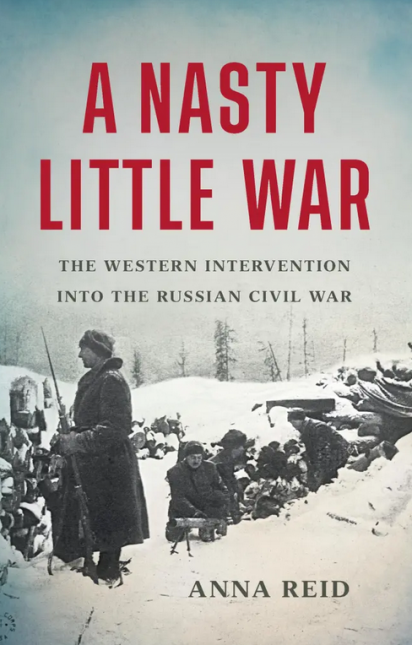A Nasty Little War: The Western Intervention into the Russian Civil War
- By Anna Reid
- Basic Books
- 400 pp.
- Reviewed by Andrew M. Mayer
- March 18, 2024
A stellar account of a long-ago, still resonant slice of 20th-century history.

Anna Reid, Kyiv correspondent for the Economist and Daily Telegraph, has written in A Nasty Little War the ultimate history of “the forgotten war” of the 20th century: the West’s involvement in the 1917-1920 Russian Civil War. In the book, she examines the conflict from various stages of the intervention. First, World War I, still in progress, fueled the Russian Revolution that ended the rule of Tsar Nicholas II in February 1917. The subsequent Kerensky Provisional Government lasted through an attempted military coup later in the summer but fell to Vladimir Lenin’s Bolsheviks in November. By this time, former tsarist elements comprising the anti-Lenin White movement had left Petrograd and Moscow and splintered into Crimea, the Caucasus, and Siberia.
When the Germans fought their way into the Baltics in 1918, the Bolshevik Reds were forced to cede territory via the Treaty of Brest-Litovsk. This freed up additional German troops for an all-out offensive on the Western Front. Things were looking bleak for Lenin and Leon Trotsky but, as Reid notes, the Whites themselves were splintering well before the November 1918 Armistice ending the Great War was signed in a railway car in Compiègne, France.
Assorted issues forced the extension of Russia’s post-Revolution civil war and Western involvement in it, chief among them the West’s desire to keep Germany from capitalizing on the power vacuum left by Russia’s ongoing instability. When, in 1918, the pro-Whites, pro-Western Czechoslovak Legion became stranded inside Russia, troops from Great Britain, France, the United States, Canada, and even Japan (not Western, but no friend of the Soviets) were deployed to help the Czech fighters by fortifying the cities of Archangel, Murmansk, and Vladivostok.
While Britain’s prime minister, David Lloyd George, his opposite number in France, Georges Clemenceau, and President Woodrow Wilson had agreed during the Treaty of Versailles peace negotiations to support the Whites, it soon proved difficult to keep Allied troops in Siberia and elsewhere in Russia, and to get additional men to volunteer for service. Splits began to occur in the alliance when Wilson decided that, although America would provide troops and supplies to Vladivostok, it would not join Japanese, French, and British troops in fighting the Bolsheviks. Soon, the French grew discouraged and stopped actively supporting the Whites as well. Finally, by 1920, the Brits realized the effort — like the Whites’ cause — was hopeless and also departed.
The problem that ultimately defeated the Whites was the lack of coordination among its forces in the north (led by Nikolai Yudenich, Evgeni Miller, and Anatoly Lieven), east (led by Alexander Kolchak), and south (led by Anton Denikin). At one point, Great Britain’s secretary of state for war, Winston Churchill, expected White forces to take Petrograd and then Moscow. But delays were such that Trotsky was able to establish a bona-fide Red Army for Lenin that first defensively held major cities, and later went on offense against the Whites.
Along with chronicling the fighting, Reid demonstrates her superior archival research by masterfully painting a picture of the domestic political realities facing the Western powers at the time. Clemenceau was shot by an anarchist during the 1919 Versailles treaty talks, survived the attack and finished the negotiations, but was later replaced in government. Lloyd George soldiered on in England’s coalition government but encountered opposition in the House of Commons to continuing “Churchill’s expedition” in Russia — especially given Churchill had been blamed for the disastrous Gallipoli landings in World War I. And Wilson, despite returning to America during the peace talks to bolster his Fourteen Points/League of Nations proposal, faced mounting opposition from isolationist Republicans in Congress and also had to deal with the “Red Scare” of 1919.
The author widens her lens to target lesser-known events from this period, too, such as the Polish-Russian war of 1920, during which Russian troops mounted an attack on the gates of Warsaw, only to be beaten back by heroic Poles. She also explores how, during that period and earlier, the Cossacks, supposedly under the control of Kolchak and Denikin, ran rampant through Jewish towns and villages and — along with the Poles — launched pogroms that left many thousands dead and wounded. The attitude of the West toward these atrocities was one of benign neglect, illustrating the antisemitism of the day.
Finally, Reid applies the lessons of the long-ago Western intercession in Russia to today’s Russia-Ukraine war, showing that, despite a century gone by, ill will has not ceased to exist in the region. Poland, the Baltics, Russia, and, sadly, Ukraine have long histories of antisemitism. We can only hope worldwide attention to the current conflict will force the negative realities of the past, laid out so brilliantly in this book, into the open and lead to a peaceful resolution to the ongoing war.
Andrew M. Mayer is professor emeritus of humanities and history at the College of Staten Island/CUNY.

